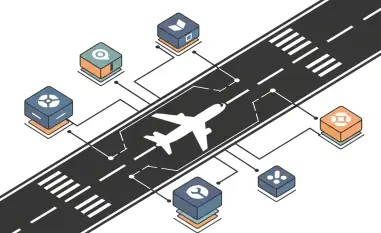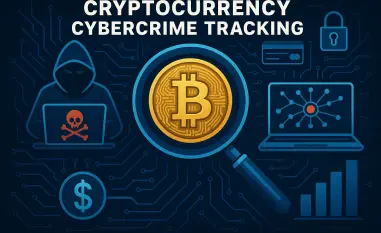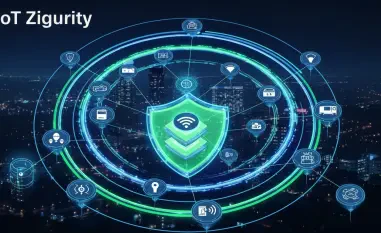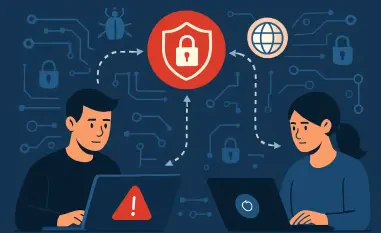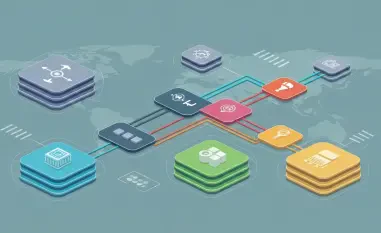The rise in cyberattacks rooted in software supply chain vulnerabilities has made software supply chain security a critical concern for organizations and government entities alike. The SolarWinds breach is a notorious example that underscores the need for enhanced security measures. This article delves into the current trends and best practices in software supply chain security, highlighting the importance of proactive measures and cohesive strategies.
The Growing Threat Landscape
The escalation of cyberattacks targeting the software supply chain has become a prominent concern for cybersecurity professionals worldwide. With cybercriminals increasingly focusing on the weak links in software development and distribution, the frequency and ease of such attacks have dangerously risen. Open-source package repositories, which form an integral part of the software ecosystem, have seen a staggering 1,300% increase in threats over the past year alone. This alarming trend points to an urgent need for more stringent security protocols designed to detect and combat potential threats before they can compromise sensitive data and disrupt essential services.
An essential factor amplifying these vulnerabilities revolves around the disjointed practices prevalent within many organizations concerning software control. As noted by Xin Qiu, Sr. Director of Security Product Marketing and Management at CommScope, companies often have numerous tools at their disposal but suffer from a lack of integration. This challenge is compounded by inconsistent practices and a siloed approach to software management, hindering effective control over software and devices. Addressing these organizational silos and adopting cohesive strategies is crucial. Without a unified approach to software control, even the most advanced security tools might fail to provide the desired protection against increasingly sophisticated cyber threats.
Increasing Frequency and Ease of Attacks
The convenience and increasing availability of open-source components have significantly contributed to the rising frequency and ease of attacks on the software supply chain. Open-source repositories, favored for their efficiency and collaborative nature, also present an attractive target for cybercriminals. The dramatic 1,300% uptick in threats in these repositories over the past year exemplifies the urgent need for stringent security measures. Malicious actors exploit vulnerabilities in open-source code, embedding malware or other malicious elements, which can then proliferate through the software supply chain undetected. Therefore, implementing robust scanning and monitoring tools is essential for identifying and mitigating these threats.
Moreover, cybercriminals are constantly refining their tactics, making it easier to launch successful attacks. Automated tools and sophisticated malware now enable attackers to exploit vulnerabilities rapidly and at scale. This environment creates a pressing need for organizations to develop and maintain robust security protocols capable of addressing these evolving threats. Early detection and prevention mechanisms are crucial as they help in combating potential compromises before they escalate into significant security breaches, ultimately safeguarding sensitive data and maintaining the integrity of the software development process.
Disjointed Organizational Practices
Despite having an arsenal of tools at their disposal, many organizations struggle with a lack of integration and consistency in software control measures. This fragmentation often leads to a siloed approach where security practices are not uniformly applied across the entire organization. Xin Qiu from CommScope highlights this challenge, noting that without cohesive strategies and standards, even the most sophisticated security tools cannot achieve their full potential. The disjointed practices hinder effective control over software and devices, reducing the overall efficacy of security measures. Thus, it is imperative for organizations to adopt unified practices and create an integrated security framework to protect their software supply chains effectively.
Addressing these organizational silos involves fostering greater collaboration and communication among different departments and teams. It requires establishing centralized management and oversight of security practices to ensure consistency and coordination. Implementing standardized protocols and creating a culture that prioritizes security can significantly enhance the effectiveness of existing tools and solutions. Additionally, investing in continuous training and awareness programs for employees and stakeholders is vital to keep pace with the dynamic threat landscape and maintain a resilient software supply chain.
Government Initiatives and Frameworks
The federal government has taken a proactive stance in addressing software supply chain security issues, recognizing the growing imperative to safeguard national cybersecurity. A prime example is the Executive Order (EO) issued by the Biden administration, which focuses extensively on enhancing cybersecurity across critical infrastructure and federal networks. This EO emphasizes the need to protect the software supply chain, imposing requirements for vendors to provide greater transparency and accountability. These initiatives represent crucial steps toward fortifying the nation’s cybersecurity posture, signaling a significant commitment to addressing the evolving threat landscape.
Complementing the EO, the Enduring Security Framework (ESF) Software Supply Chain Working Panel has developed a comprehensive guide for recommended security practices specifically tailored for developers. This guide aims to provide best practices that developers can integrate into their workflows, enhancing the security of their software products from the ground up. By following these recommendations, organizations can better protect their software supply chains and minimize the risk of cyberattacks. The collaborative effort between government agencies and industry experts ensures that these guidelines are both practical and effective in mitigating security risks.
Executive Order and Enduring Security Framework
The Executive Order issued by the Biden administration marks a significant milestone in bolstering the nation’s cybersecurity efforts, particularly concerning the software supply chain. This landmark initiative mandates enhanced transparency from vendors, requiring them to provide a Software Bill of Materials (SBOM) that details the components used in their software products. By doing so, the EO aims to ensure that all stakeholders have a clear understanding of the software’s makeup, enabling more informed risk management and compliance decisions. This level of transparency is crucial in identifying and addressing vulnerabilities before they can be exploited by malicious actors.
In tandem with the Executive Order, the Enduring Security Framework (ESF) Software Supply Chain Working Panel plays a pivotal role in guiding developers towards better security practices. The guidelines provided by the ESF focus on aspects such as secure coding, rigorous testing, and continuous monitoring of software throughout its lifecycle. By embedding security considerations into every phase of software development, these recommendations help create a more resilient supply chain. The collective adoption of these best practices by the development community can significantly mitigate the risk of cyberattacks, enhancing the overall security landscape.
NIST’s Framework for Securing the Software Supply Chain
To further strengthen the software supply chain, the National Institute of Standards and Technology (NIST) has developed a comprehensive framework designed to guide organizations through best practices and security measures. This framework offers a structured approach for mitigating risks and enhancing security across various stages of the software development and deployment process. It provides detailed recommendations that cover aspects such as secure design principles, access controls, vulnerability management, and incident response. By adhering to these guidelines, organizations can systematically address potential vulnerabilities and build a more secure software supply chain.
The NIST framework serves as a critical reference for both public and private sectors, establishing a common language and set of practices for securing software supply chains. It emphasizes the importance of adopting a risk-based approach, encouraging organizations to identify and prioritize their most critical assets and threats. This methodology enables more strategic allocation of resources and more effective mitigation of potential risks. Additionally, the NIST framework is not static; it is regularly updated to reflect the evolving threat landscape and advancements in technology, ensuring that organizations remain equipped to address new challenges as they arise.
Key Security Solution Trends
In response to the escalating threat landscape and the complexities of securing software supply chains, several key security solution trends have emerged. These trends focus on proactive measures, community collaboration, and the adoption of structured frameworks to enhance security and resilience. One of the most significant trends is the “Secure by Design” initiative. Advocated by CISA Director Jen Easterly and cybersecurity professionals at RSAC2024, this approach emphasizes building security into products from the initial design phase. By integrating security considerations early in the development process, organizations can reduce exploitable flaws before products reach the market, leading to more robust and resilient software.
Another critical trend is the implementation of Software Bill of Materials (SBOMs), which provide a detailed inventory of components within a software application. SBOMs are crucial for identifying and managing risks, ensuring compliance, and making more informed security decisions. Endorsed by CISA, SBOMs have become an integral part of the software supply chain security landscape, with regular community meetings and resources provided to encourage their use and understanding. Additionally, frameworks like the Supply-Chain Levels for Software Artifacts (SLSA) and Governance, Risk, and Compliance (GRC) management systems play vital roles in bolstering supply chain security by providing structured approaches and comprehensive oversight.
Secure by Design
The “Secure by Design” initiative is gaining traction as an essential strategy for enhancing software security. This approach advocates for integrating security measures from the very beginning of the software development lifecycle, rather than treating security as an afterthought. By prioritizing security in the design phase, companies can identify and address potential vulnerabilities before they become ingrained in the final product. CISA Director Jen Easterly and cybersecurity professionals at RSAC2024 have championed this initiative, highlighting its importance in creating more secure and resilient software. Over 200 organizations have pledged to implement Secure by Design principles, reflecting the growing acceptance and recognition of this proactive security strategy.
Adopting Secure by Design principles involves several key practices, including secure coding standards, thorough security testing, and ongoing vulnerability assessments. Organizations are encouraged to incorporate security requirements into their development processes and to engage security experts throughout the product’s lifecycle. By fostering a culture that prioritizes security, companies can significantly reduce the likelihood of exploitable flaws and create more robust software. This shift towards proactive security measures can help organizations stay ahead of emerging threats and build stronger defenses against potential cyberattacks.
Software Bill of Materials (SBOMs)
Software Bill of Materials (SBOMs) have emerged as a critical tool in enhancing the security of the software supply chain. An SBOM provides a comprehensive inventory of all components within a software application, including open-source elements, third-party tools, patch statuses, and licenses. This detailed documentation allows organizations to identify and manage risks more effectively, ensuring that they are aware of all dependencies and potential vulnerabilities within their software. By implementing SBOMs, companies can make more informed security decisions and maintain better compliance with industry standards and regulatory requirements.
Endorsed by CISA, SBOMs are increasingly recognized as an essential component of the software supply chain security landscape. The adoption of SBOMs facilitates greater transparency and accountability, enabling organizations to track and monitor the components used in their software products. This level of visibility is crucial for identifying potential risks and ensuring that all software components are up to date and free from known vulnerabilities. CISA regularly holds community meetings and provides resources to encourage the use and understanding of SBOMs, fostering a collaborative approach to enhancing software security.
Supply-Chain Levels for Software Artifacts (SLSA) Framework
The Supply-Chain Levels for Software Artifacts (SLSA) framework is designed to protect the integrity of software artifacts by providing a structured approach to evaluating and enhancing software security. Developed based on Google’s production workloads, SLSA includes a checklist of standards aimed at preventing tampering and ensuring secure infrastructure and application packages. This framework offers a systematic way to assess and improve software security throughout the supply chain, making it an invaluable tool for organizations seeking to bolster their defenses against potential cyber threats.
SLSA’s structured approach to security involves several key components, including securing the build process, verifying source integrity, and ensuring the reproducibility of builds. By adhering to these standards, organizations can create a more secure and reliable software development environment. SLSA also emphasizes the importance of continuous monitoring and assessment, encouraging companies to regularly review and update their security practices to stay ahead of emerging threats. This proactive approach helps organizations maintain the integrity of their software artifacts and protect against potential tampering and other malicious activities.
Governance, Risk, and Compliance (GRC) Management
Governance, Risk, and Compliance (GRC) management has become a crucial aspect of mitigating security risks within the software development supply chain. GRC encompasses a range of activities, including risk identification, vendor risk management, compliance management, policy enforcement, and incident response. By implementing GRC management systems, organizations can ensure that they are adhering to industry and government security standards while effectively mitigating potential risks. GRC tools often integrate with SBOM analysis to provide comprehensive security oversight, making them an essential component of a robust security strategy.
Effective GRC management involves establishing clear policies and procedures that define how security risks are identified, assessed, and mitigated. It also requires continuous monitoring and evaluation to ensure compliance with relevant standards and regulations. By adopting a holistic approach to GRC, organizations can create a more resilient software supply chain and enhance their overall security posture. This comprehensive oversight enables companies to proactively address potential vulnerabilities and respond swiftly to security incidents, thereby minimizing the impact of cyberattacks on their operations.
The Path Forward
The increase in cyberattacks due to software supply chain vulnerabilities has elevated software supply chain security to a critical concern for organizations and government bodies. A stark reminder of this is the infamous SolarWinds breach, which highlighted the urgent need for stronger security measures. This incident has brought to light the necessity for both public and private sectors to adopt advanced security protocols. This article explores the latest trends and best practices in software supply chain security, emphasizing the significance of proactive measures and unified strategies.
Organizations must prioritize identifying and mitigating risks within their supply chains to prevent potential threats. Employing robust vetting processes for third-party vendors and continuously monitoring and updating software are key steps in fortifying security. Additionally, fostering a culture of security awareness and collaboration among stakeholders can enhance the overall resilience of the supply chain. By implementing comprehensive security frameworks and staying abreast of evolving threats, entities can better safeguard their software infrastructure against sophisticated cyberattacks.


